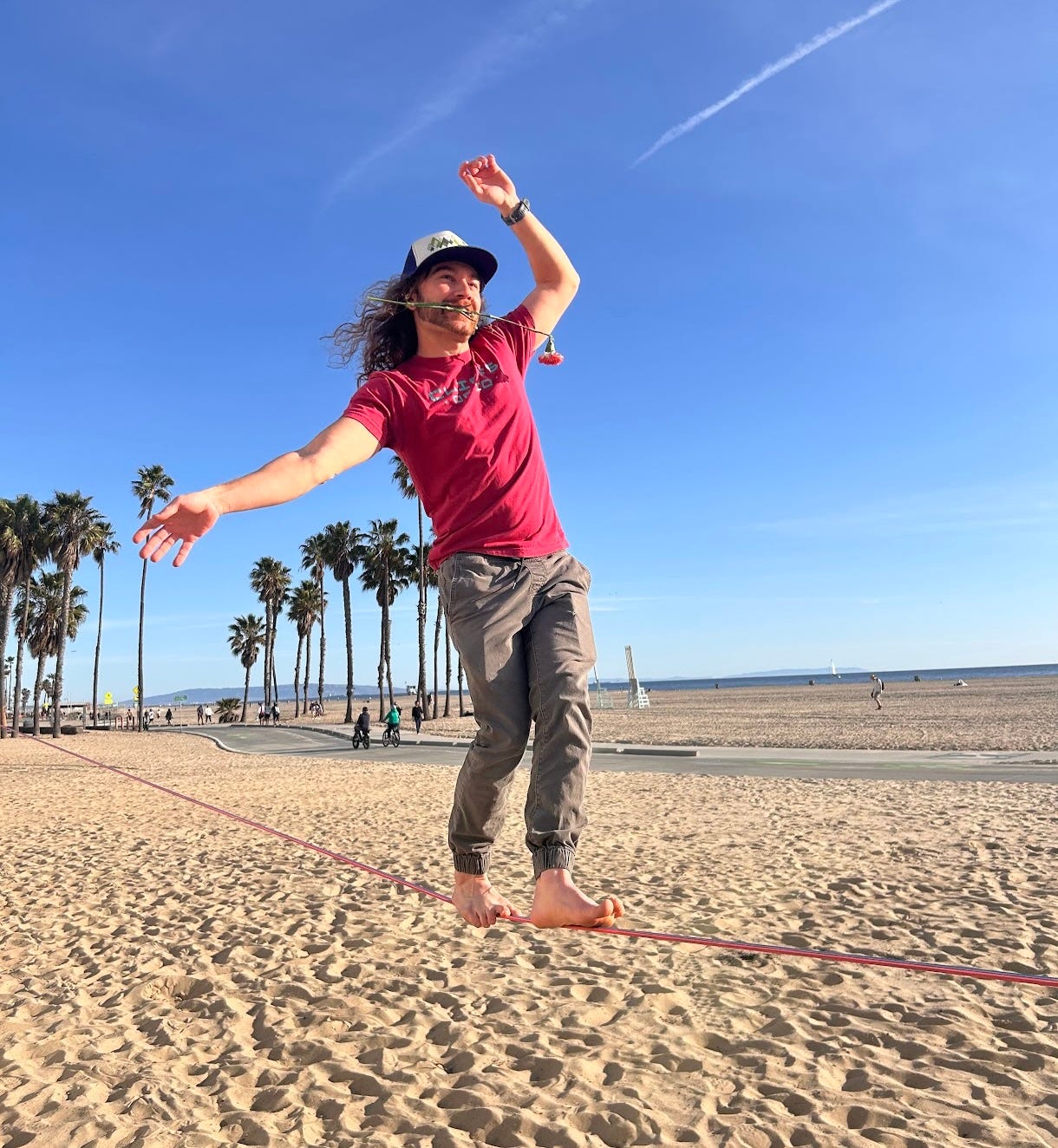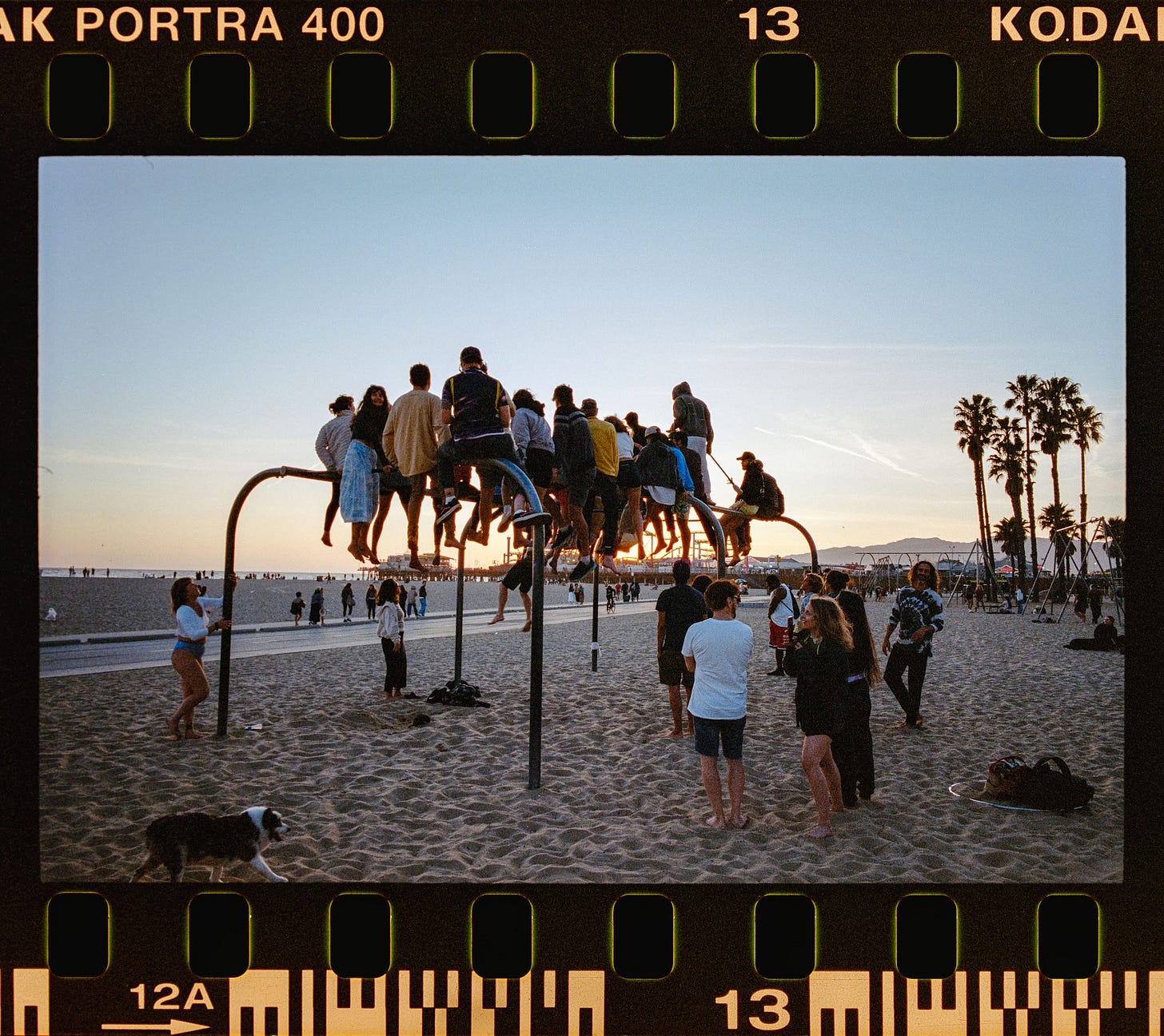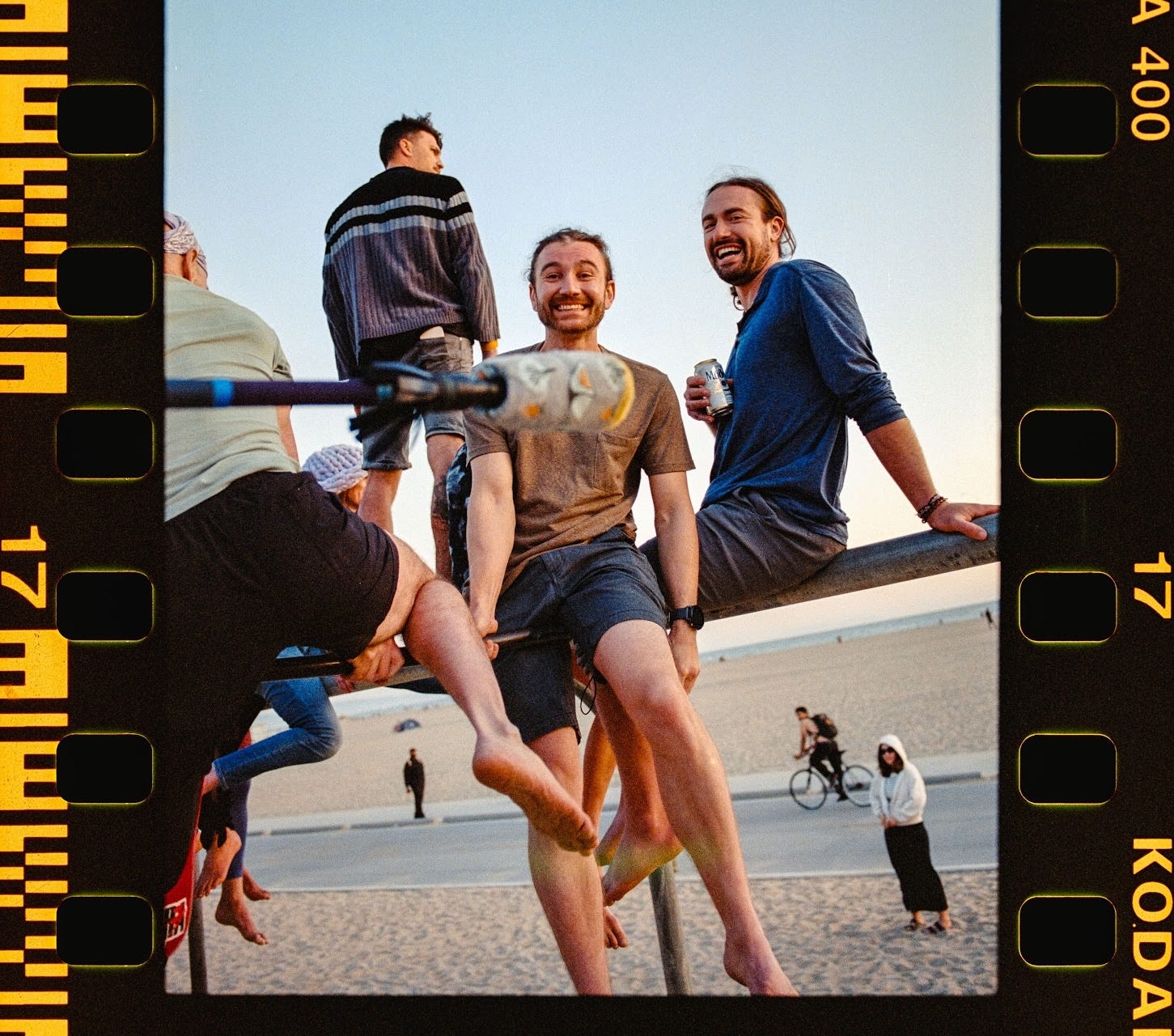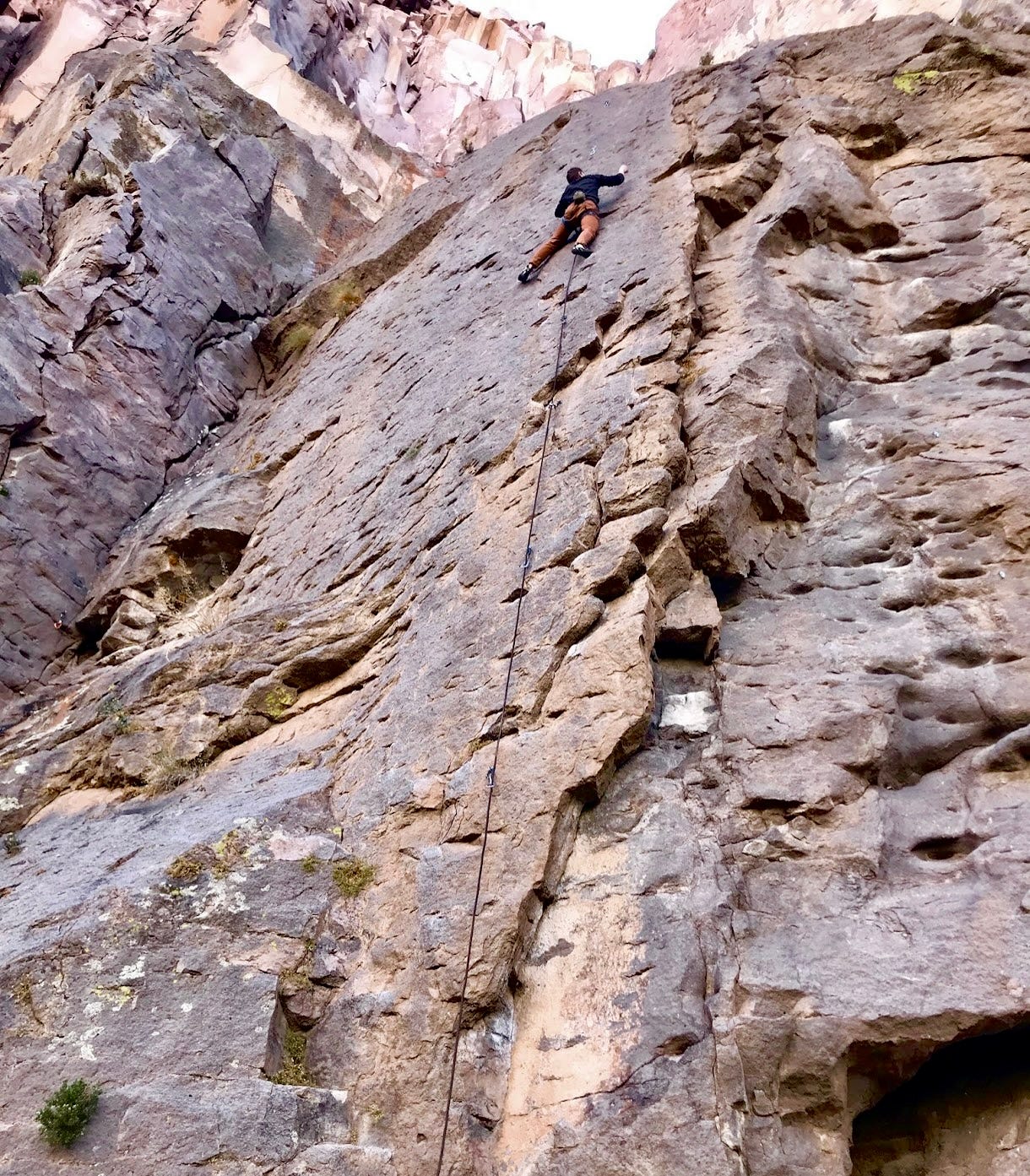Beyond the Heights, Belonging to Amazing People
Seasoned Slackliner, Climber, Muscle Beach Gymnast, Ardavan Tavakoli shares his story on Presence and Belonging
Imagine walking across a rope hundreds of feet in the air, scaling sheer granite cliffs, or soaring through the air on the rings at Muscle Beach.
This is the world of Ardavan Tavakoli (Ardy for short). Ardy immigrated from Iran as a child and found a home in the heart of Los Angeles and the Original Muscle Beach community. For over 16 years, Ardy has dedicated himself to slacklining, climbing, and mastering traveling rings.
I’ll never forget my first time meeting Ardy. It was a sunny day at Santa Monica Beach, and he stood by the slackline park with his Pit Vipers and Chacos holding a beer. I thought to myself, "This guy is definitely a climber." He showed me how to walk across a slackline for the first time, and that same day, we became friends who would go on many adventures together.
Ardy's story of immigration, his connection to Muscle Beach, and his pursuit of gravity-defying slacklining and climbing make him an adventurer I deeply respect. I recently sat down with Ardy to uncover the layers of his story, exploring his connection to fear, and his sense of belonging within the outdoor community.
Interview with Ardavan Tavakoli
Who are you and what is your background?
I’m Aradvan and I’m a Slackliner and Climber. I was originally born in Tehran, Iran. I immigrated to the US when I was nine years old. When I came here the only English words I knew were “yes” and “no”. When we came here we first moved to Tennessee. There were no Persians, so that was difficult, but after a year we moved to Los Angeles and have been in Santa Monica ever since.
The outdoors has always been a huge part of my life. I started backpacking when I was four years old with my family in Iran. I’m not talking about two nights of camping. We would go for two weeks of backpacking and I’ve always felt a draw to adventure and the outdoors.
I want to talk about before you became a seasoned climber and slackliner. How did you first discover your passions and Original Muscle Beach?
“The original Muscle Beach began in Santa Monica in the 1930s, known for its gymnastics and acrobatic displays, and is considered the birthplace of the US fitness. In contrast, Muscle Beach Venice, established later in a different location, became famous for weightlifting and bodybuilding, attracting legends like Arnold Schwarzenegger. While both hold significance in fitness history, the Santa Monica location is recognized as the "Original" and retains a focus on gymnastics, while Venice is the contemporary hub for bodybuilding.”
It started when I was working at the Santa Monica Pier in High School when I was seventeen. I would work the game booths after school every day while I went to Samohi. So, I saw Muscle Beach all of the time, but going there was super intimidating. I saw all of these incredible people doing crazy things like acro, rings and climbing ropes. But, I didn’t want to go alone, so I held back.
When I was nineteen, I graduated High School and I was exploring what was next. My youth pastor at my church knew I was interested in the outdoors and he told me he thought I would be interested in this thing called, “slacklining”. He said, “I think you might really like it”.
One day, I met him at the small rings at the beach and I tried slacklining for the first time. I immediately fell in love with the sport. I remember walking my first line and going from never slacklining to picking it up in a day. It took me two hours of non-stop practice to not fall. Instantly, I was hooked. I would spend 10 hours a day (getting there at 8 am) slacklining and doing traveling rings 7 days a week for that entire summer.
Was there a moment when you realized slacklining and the beach rings were more than just a pastime for you?
Yes, the second I tried it I knew I loved the sport and that I wanted to dedicate myself to it, but I also love that it’s an individual sport. There is a community you hang out with (I’ll talk more about this), but being on the slackline is all you.
The slackline is a good lie detector. It tells you if you are truly being present, breathing, if you are relaxed, if your shoulders are tense, etc. If you don’t do all of the right things to be present, then you fall off. You can’t be focused on the steps you have taken before or the steps you are about to take. You are 100% in the moment and you take one step at a time. When you feel relaxed the line relaxes with you.
I can tell what type of day I am having based on how I am slacklining. If I am super relaxed and present, the slackline moves with me. But, if I am stressed, I wobble and fall off. Being on the line is a zen moment. Even now, 16 years after I first started in 2009, nothing else creates such a deep sense of presence in my body and mind. That is the reason why I still do it every week and bike down to the beach every Sunday.
Another cool part about slacklining is the falling. Falling is a part of it. A lot of people try slacklining, they fall and they give up. But, it’s about getting up and continuing. That is what separates people from the sport. The determination of someone willing to fail and continue is the key to becoming a good slackliner. Because you are falling all of the time and it can be very discouraging. At first, it doesn’t seem like you are progressing, but eventually, you are walking, you start juggling, doing tricks, 100+ ft lines. It just goes up when you commit.
Something I wasn’t expecting was this super cool community that comes along with the sport. It takes a type of person to fail (a lot), but to continue. That mindset filters the type of people who get into slacklining. It fosters this really cool community of people who are beyond determined and do not let small failures stop them. It is easy to fall off a slackline and quit, but the community always keeps going. Even though it’s an individual sport, you are doing it with a group of people who I am connected with in so many incredible ways.
So, you do a lot of different types of slacklining. Walk me through all of the different types of lines, sports, etc. that you do.
So, I started slacklining on the beach. From there I got into longlining (a line that is set up higher and longer. About 70ft to 300+ft lines). I started doing that through meeting friends at the beach. I then started doing highlines where you are walking a line with a safety leash. With highlines, you are high enough that you can die.
Highlining was completely different back when I started. It’s more accessible now. Nowadays, you can slackline for a day and then highline the next. When I started you had to know people with the right gear, insight, and willingness to bring you out.
Slacklining has many variations, including longlining, highlining, and waterlining. From 2011 to 2015, we were doing multiple objectives in a day and constantly rigging and de-rigging equipment. In the summer I would waterline at an event called “Wet Wednesdays” in Malibu Creek, followed by slacklining on the beach. It as also easy to swing over to nearby highlining and longlining spots in Stoney Point and Topanga.
Rigging: the term for setting up the Highline is a safe way.
De-rigging: taking it down.
There’s a big culture around traveling to slackline. I go to these community events called “gatherings” where we spend time with people in the community, rigging lines and hanging out. It’s awesome to be surrounded by people with the same type of mindset: they never take “no” for an answer and are constantly setting up new and bigger objectives.
All of this is incredible, and I personally am so drawn into learning more about highlining. It’s insane. Tell me more about your experience highlining.
First off, it’s super safe and there are very few reports of major incidents on a highline per year. But, if it does happen it’s due to human error. It is a safe sport, but it’s the most dangerous feeling sport. I have a friend who does base jumping and base jumping is statistically one of the most dangerous sports. I got him to come out to a highline and he said the feeling of being on a highline was much scarier than any base jump he had ever done. Even though highlining is significantly one of the safest sports, it feels incredibly scary.
What does it feel like for you?
I am terrified, haha. People think I am fearless, but the reality is that I’m afraid when I’m about to stand up on the line. I am fighting for every step. It goes back to the mindset of doing something terrifying, but overcoming your fears, failure, all of the different obstacles and not letting those stop you. When you are sitting on a high line it’s an insane feeling to look down hundreds or thousands of feet below. Everything in your body tells you you are not supposed to be here.
My body just freezes and I have to sit there for 5 minutes and work on my breathing, lowering my heart rate, and talking down my nervous system. I have to constantly remind myself that this is safe, I have done this on the ground and I can do this here. It is beautiful to overcome those fears. You think it gets easier, but I feel the same as I did when I started. I went this last weekend and I was still terrified. But, it’s about overcoming.
How do you overcome fear?
Focusing back on the basics like breathing and slowing down your heart rate. Relaxing, being present, and avoiding focusing on the past or the future steps. It’s not going to help you at that moment. You have to be 100% present when you stand up and every single step after that.
What inspired your move from slacklining to climbing—and eventually into the world of Yosemite?
It generally is a super natural progression. Slacklining comes from rock climbers. This came from Yosemite in Camp 4 in the late 70’s where it was a resting sport for climbers (article). Rock climbers in Yosemite were walking on chains as a form of resting which transitioned into webbing between trees. Now slacklining is its own sport and it doesn’t matter which one you start first because the skills are intertwined. You have to have a lot of rock climbing skills for highlines and you need to be a rock climber to rig some lines. So, they are definitely complementary sports and you need both if you want to reach a certain level.
What is your draw with climbing / what is your style of climbing?
Right now, I am primarily doing sport climbing. It is the most accessible than any other climbing when it comes to outdoor climbing. The second would be trad climbing up crack systems, but that requires traveling to different locations like Yosemite or Joshua Tree. I don’t boulder as much outdoors right now, but I do love it especially when going to Yosemite or Joshua Tree and doing it with a group of friends.
I know Yosemite is a big part of your life and that we can talk forever about it. How is Yosemite a part of your identity?
Oh man, we might need hours to talk about this. Yosemite is a huge part of my identity and journey. It’s the place I started rock climbing. Most people who start rock climbing start in a gym and then eventually work their way up to the outdoors. The first time I ever rock climbed, I mean ever (never indoors), putting on rock climbing shoes and climbing was in Yosemite.
It is also home to all of the “greats”. I remember seeing pictures of Dean Potter back in 2010 highlining in Yosemite and I was like, woah, I would love to be at that point one day. It was a huge inspiration for me. All of these people are doing cool things in Yosemite. In some ways, I have achieved this where I have highlined in Yosemite.
Do you remember your first time in Yosemite?
The first time, I went to Yosemite, I was like, wow… There is no other place or feeling when you are in Yosemite. It is the most beautiful, vast, and grand I have ever seen in my life. I feel so small and surrounded by beauty in every direction. One of my favorite things in summer is to bike and sit on the El Cap bridge. You are just sitting there and there is a 3000 ft granite wall in front of you with all of these tiny little dots of climbers.
The beauty, the nature and the cool history; it all comes together and it contributes to my sport. Millions of people come from all over the world to see the beauty of Yosemite, but you can enjoy it from a different point of view as a climber.
You belong to so many cool things. Yosemite, climbing, slacklining, your Iranian heritage. What does the word “belonging” mean to you today?
Community. One of the coolest things about slacklining is the culture of our community. We accept people with open arms and meet them where they are. You have this sense of belonging that is not like other sports. Even in rock climbing the culture is not as open as slacklining. You can feel a sense of belonging even though you have done the sport for years or just one hour. No one looks down on you and being there slash trying is enough.
I also get the opportunity to travel to really cool places that reconnect me with my childhood. It's in these amazing places, among inspiring people, that I feel present and myself – it’s a true gift.
Ardy's story is a powerful reminder that when you overcome your fears you can find adventure, have the courage to explore new passions, and always connect with inspiring people. If you're in Los Angeles, you can head to the Original Muscle Beach slackline area on Sundays where you might just meet Ardavan (instagram: @ardyslacks), discover a vibrant community and a sport you'll love.
If you would like to connect or write, for The Belonging Project, please reach out directly via Substack as we would love to collaborate!
Songs:
Fallss - Gigamesh Remix, Bayonne Gigamesh
You can listen to The Belonging Project Playlist on Spotify




















OMG I’m sweating just thinking about it. All the air up there.
I’m on my second slackline. I’ve trained parkour for years. I know how strong 3/4” glass is, but I can’t stand on it thousands of feet over the Grand Canyon even when there’s a guard rail. I can slackline on the beach but I’m nervous on a 40th floor balcony. But somehow the organic spaces are less scary. I’m more at peace on an 1,800’ peak with near vertical drops on all sides after scaling a 12’ wall to get there than I am 100’+ up a building that was designed by a structural engineer. The structure has safety factors designed in, but the pumice can crumble any moment.
This post is incredible, it definitely deserves more recognition! Beautiful message and awesome pics!